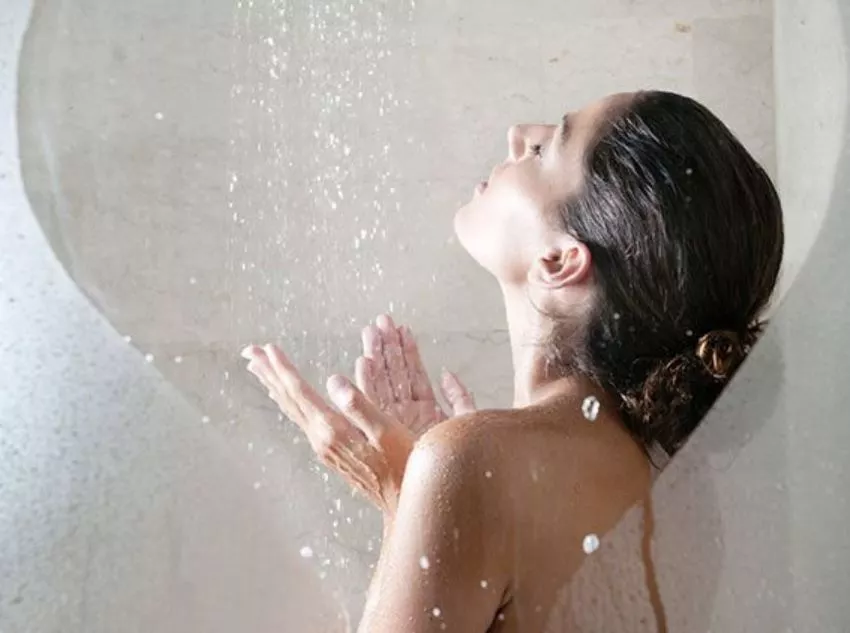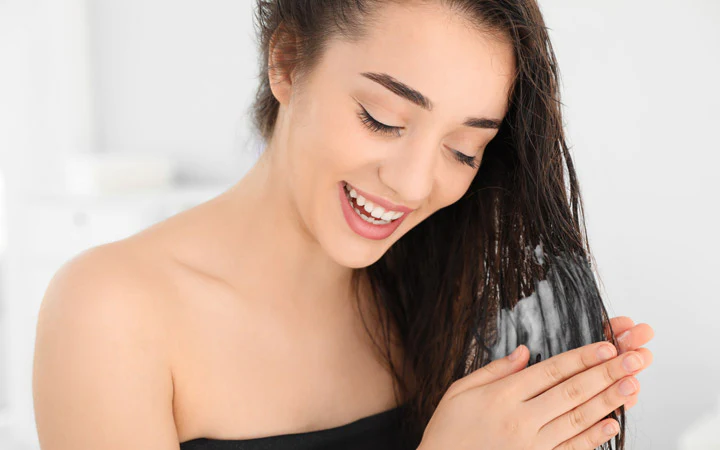Here are some hair care tips to help you maintain healthy and shiny hair:
- Regular washing: Wash your hair regularly to keep it clean and remove dirt, excess oil, and product buildup. Choose a gentle, sulfate-free shampoo that suits your hair type and follow with a conditioner to keep your hair moisturized and smooth.
- Proper conditioning: Conditioning is essential for maintaining hydrated and shiny hair. Apply conditioner mainly to the lengths and ends of your hair, as these areas tend to be drier. Leave the conditioner on for a few minutes before rinsing thoroughly.
- Use lukewarm water: Avoid using hot water when washing your hair, as it can strip away natural oils and cause dryness. Rinse with lukewarm water to help maintain the hair’s moisture balance.
- Protect from heat styling: Limit the use of heat styling tools such as flat irons, curling irons, and blow dryers, as excessive heat can damage the hair shaft and lead to dullness and breakage. If you do use heat styling tools, apply a heat protectant spray or serum beforehand to minimize damage.
- Minimize chemical treatments: Chemical treatments like perming, relaxing, or coloring can weaken the hair and make it more prone to damage. If possible, minimize the use of harsh chemical treatments or seek professional advice to ensure proper hair care during and after these processes.
- Avoid excessive brushing: Brushing your hair too vigorously or using the wrong type of brush can cause breakage and damage. Use a wide-toothed comb or a brush with soft bristles to gently detangle your hair, starting from the ends and working your way up.
- Protect from environmental damage: Protect your hair from environmental factors such as sun exposure, wind, and pollution. Wear a hat or use a scarf to shield your hair from the sun’s harmful rays, and rinse your hair after swimming in chlorinated or saltwater.
- Trim regularly: Regular trims help prevent split ends and breakage, keeping your hair looking healthier and more vibrant. Aim to trim your hair every 6-8 weeks, or as needed, to maintain its overall condition.
- Eat a balanced diet: A nutritious diet rich in vitamins, minerals, and protein is essential for healthy hair. Include foods like fruits, vegetables, lean proteins, nuts, and seeds in your diet to promote hair health from within.
- Hydrate and reduce stress: Stay hydrated by drinking an adequate amount of water daily. Additionally, manage your stress levels through relaxation techniques, exercise, and self-care practices, as stress can impact the health and appearance of your hair.
Remember that everyone’s hair is unique, and it may take some experimentation to find the best hair care routine and products that work for you. If you have specific concerns or hair conditions, it’s always a good idea to consult with a professional hairstylist or trichologist for personalized advice and recommendations.
Table of Contents
Hair Care Tips
Regular washing
Regular washing is an important part of maintaining healthy and clean hair. Here are some guidelines for regular hair washing:
- Frequency: The frequency of hair washing depends on various factors, including your hair type, scalp condition, and lifestyle. Generally, washing your hair 2-3 times a week is suitable for most people. However, if you have an oily scalp or engage in activities that make your hair dirty or sweaty, you may need to wash more frequently.
- Use the right shampoo: Choose a shampoo that is suitable for your hair type and concerns. If you have oily hair, opt for a clarifying or oil-control shampoo. For dry or damaged hair, use a moisturizing or hydrating shampoo. If you have a sensitive scalp, look for a gentle, fragrance-free shampoo. Avoid shampoos containing sulfates, as they can strip away natural oils and cause dryness.
- Scalp massage: Before applying shampoo, give yourself a scalp massage using your fingertips. This helps stimulate blood circulation and can improve the health of your scalp and hair follicles.
- Proper application: Wet your hair thoroughly and apply a small amount of shampoo to your palms. Gently massage the shampoo into your scalp using your fingertips, focusing on the roots. Avoid using excessive force or rubbing, as it can cause friction and damage to the hair shaft. Let the shampoo work for a minute or two before rinsing thoroughly.
- Conditioning: After shampooing, apply a conditioner to the lengths and ends of your hair. Avoid applying conditioner to the scalp, as it can weigh down the hair and make it appear greasy. Leave the conditioner on for a few minutes, then rinse thoroughly with cool water to seal the hair cuticles and add shine.
- Towel drying: After washing, gently squeeze out excess water from your hair using a soft towel. Avoid rubbing vigorously, as it can cause friction and lead to breakage. Instead, pat or blot your hair dry.
- Styling considerations: If you use heat styling tools or apply styling products, follow the recommended usage guidelines and use heat protectants when necessary. Avoid applying excessive heat or products that contain harsh chemicals, as they can damage the hair over time.
Remember that individual hair types and needs may vary, so it’s important to adjust your washing routine accordingly. If you have specific concerns or scalp conditions, it’s advisable to consult with a professional hairstylist or dermatologist for personalized advice and recommendations.

Use lukewarm water
using lukewarm water for hair care is generally recommended. Here are the benefits of using lukewarm water:
- Scalp and hair health: Lukewarm water is gentle on the scalp and hair. It helps to maintain the natural oils on the scalp, preventing excessive dryness or oiliness. Lukewarm water also helps to minimize scalp irritation and itching.
- Moisture retention: Hot water can strip the hair of its natural oils and moisture, leaving it dry and brittle. Lukewarm water helps to preserve the hair’s natural moisture, keeping it hydrated and less prone to breakage and frizz.
- Color preservation: If you have color-treated hair, lukewarm water is ideal for preserving the vibrancy and longevity of your hair color. Hot water can cause the color molecules to fade more quickly, while lukewarm water helps to minimize color loss.
- Hair cuticle care: Lukewarm water is less likely to cause damage to the hair cuticles. Hot water can cause the cuticles to expand and become rough, leading to frizz and dullness. Lukewarm water keeps the hair cuticles smoother, resulting in shinier and healthier-looking hair.
- Scalp stimulation: Lukewarm water can still provide a mild stimulating effect on the scalp, improving blood circulation and promoting overall scalp health. This can contribute to healthier hair growth.
To incorporate lukewarm water into your hair care routine, start by rinsing your hair with lukewarm water during shampooing and conditioning. When rinsing out the products, use lukewarm water to ensure proper removal without causing unnecessary dryness or damage.
Remember that individual preferences and hair types may vary, so adjust the water temperature to what feels comfortable and suitable for your hair. If you have specific concerns or conditions, it’s always a good idea to consult with a professional hairstylist for personalized advice.

Proper conditioning
Proper conditioning is essential for maintaining healthy, hydrated, and manageable hair. Here are some tips for effective conditioning:
- Choose the right conditioner: Select a conditioner that is suitable for your hair type and concerns. If you have dry or damaged hair, opt for a moisturizing or repairing conditioner. For fine or oily hair, choose a lightweight or volumizing conditioner. Read the product labels and look for ingredients that nourish and hydrate the hair, such as natural oils, shea butter, or keratin.
- Focus on the lengths and ends: Concentrate the conditioner on the lengths and ends of your hair, as these areas tend to be drier and more prone to damage. Avoid applying conditioner directly to the scalp, as it can weigh down the hair and make it appear greasy. Start applying the conditioner a few inches away from the scalp and work your way down to the tips.
- Use the right amount: Use an appropriate amount of conditioner for your hair length and thickness. Too little conditioner may not provide enough hydration, while too much can weigh down the hair. Start with a quarter-sized amount and adjust as needed.
- Leave it on for the recommended time: Follow the instructions on the conditioner bottle for the recommended leave-in time. Typically, it’s advisable to leave the conditioner on for a few minutes to allow it to penetrate and moisturize the hair effectively. Use this time to gently detangle your hair with a wide-toothed comb or your fingers.
- Rinse thoroughly: Thoroughly rinse out the conditioner with lukewarm water. Make sure no residue is left behind, as it can lead to build-up and weigh down the hair. Rinse until the water runs clear and your hair feels clean and smooth.
- Adjust frequency: The frequency of conditioning depends on your hair’s needs and your washing routine. If you have dry or damaged hair, consider conditioning every time you wash your hair. If your hair is oily or fine, you may choose to condition every other wash or focus on the ends only.
- Deep conditioning treatments: Incorporate deep conditioning treatments into your hair care routine once or twice a month, or as needed. Deep conditioners provide intense hydration and nourishment to the hair, helping to repair and revitalize it. Follow the instructions on the product for the recommended application time and method.
Remember, everyone’s hair is unique, so it may take some experimentation to find the right conditioner and routine that works best for you. Pay attention to how your hair feels and make adjustments as needed. If you have specific concerns or conditions, consult with a professional hairstylist for personalized recommendations.

Protect from heat styling
Protecting your hair from heat styling is crucial for maintaining its health, minimizing damage, and preventing breakage. Here are some tips to help you protect your hair from heat styling:
- Use heat protectant products: Before using any heat styling tools, apply a heat protectant spray, serum, or cream to your hair. These products create a barrier between your hair and the heat, reducing the amount of damage caused by styling tools. Look for heat protectants that contain ingredients like silicones, polymers, or natural oils that help to shield the hair from heat.
- Adjust heat settings: Use heat styling tools at the lowest effective temperature for your hair type and styling needs. High heat can cause significant damage to the hair cuticles and lead to dryness and breakage. If possible, opt for tools with adjustable heat settings and start with the lowest setting. Gradually increase the heat only if necessary.
- Limit heat exposure: Minimize the frequency and duration of heat styling. Whenever possible, embrace air-drying or low-heat styling methods instead. Give your hair regular breaks from heat styling to allow it to recover and maintain its natural strength and moisture.
- Use the right tools: Invest in high-quality heat styling tools that distribute heat evenly and have temperature control options. Look for tools with ceramic, tourmaline, or titanium plates, as they provide more gentle and even heat distribution, reducing the risk of damage.
- Prep your hair: Before using heat styling tools, ensure your hair is clean and dry or properly prepped with a heat protectant. Wet or damp hair is more vulnerable to heat damage, so it’s essential to dry it completely before using heat styling tools.
- Style in sections: Divide your hair into sections when using heat styling tools. This allows you to work on smaller portions of hair at a time, reducing the exposure of each section to heat. It also helps ensure even styling and reduces the need for repeatedly passing the tools through the hair.
- Avoid direct heat contact: Be mindful of not applying heat directly to your hair for extended periods. Keep the heat styling tools moving constantly and avoid holding them in one spot for too long, as this can cause excessive heat damage.
- Regular trims: Schedule regular trims to remove any split ends or damaged hair. Trimming regularly helps maintain the overall health of your hair and prevents further damage from spreading up the hair shaft.
Remember, while these tips can help minimize heat damage, it’s also essential to listen to your hair’s needs. If you notice signs of damage or excessive dryness, consider reducing heat styling or consulting with a professional hairstylist for tailored advice and recommendations.
Minimize chemical treatments
Minimizing chemical treatments can be beneficial for maintaining the health and integrity of your hair. Here are some tips to help minimize chemical treatments:
- Embrace your natural hair: Embrace your natural hair texture and work with it rather than relying on chemical treatments to alter it. This can help reduce the frequency of chemical treatments and minimize potential damage.
- Limit coloring and bleaching: If you color your hair, consider opting for natural or semi-permanent dyes that are less damaging and fade gradually over time. Minimize the use of harsh bleaching agents, as they can weaken the hair and cause breakage. If possible, space out your coloring sessions and give your hair time to recover between treatments.
- Avoid chemical relaxers and perms: Chemical relaxers and perms can alter the structure of the hair and make it more susceptible to damage. If you want to achieve a different texture, explore alternative styling methods or consider temporary styling options that don’t involve permanent chemical changes.
- Opt for gentle treatments: If you do choose to undergo chemical treatments, opt for milder formulations and techniques. Look for products that are labeled as gentle, low-ammonia, or ammonia-free. Consider consulting with a professional hairstylist who specializes in more gentle and less damaging treatment options.
- Deep condition regularly: Regularly deep condition your hair to replenish moisture and nourish the strands. Deep conditioning treatments can help restore and strengthen the hair, minimizing the potential damage caused by chemical treatments.
- Protect your hair during chemical processes: If you decide to undergo chemical treatments, ensure that your hair is properly protected during the process. Follow the instructions provided by the product manufacturer or seek professional help to ensure that the chemicals are applied correctly and that your hair is not overexposed or subjected to unnecessary damage.
- Seek professional advice: Consult with a professional hairstylist or trichologist to understand the potential risks and benefits of different chemical treatments. They can assess the condition of your hair, offer personalized recommendations, and provide guidance on how to minimize damage while achieving your desired look.
Remember, everyone’s hair is unique, and the impact of chemical treatments can vary. It’s important to listen to your hair, monitor its condition, and make informed decisions about the treatments you choose. Prioritizing the overall health and well-being of your hair should be the primary consideration.
Protect from environmental damage
Protecting your hair from environmental damage is essential for maintaining its health and appearance. Here are some tips to help safeguard your hair from environmental stressors:
- Shield from the sun: Prolonged sun exposure can cause dryness, color fading, and brittleness in the hair. Protect your hair by wearing a hat or scarf when you’re out in the sun. Additionally, consider using hair products that contain UV filters to provide an extra layer of protection.
- Minimize heat and styling tool exposure: Environmental factors such as the sun, wind, and pollution can already stress your hair. Minimize additional damage by reducing the use of heat styling tools like blow dryers, flat irons, and curling wands. Embrace air-drying whenever possible and opt for heatless styling methods to give your hair a break.
- Cover up in harsh weather conditions: Extreme weather conditions like wind, cold, and dryness can strip moisture from your hair, leaving it brittle and prone to breakage. Protect your hair by wearing a hat, scarf, or hood to shield it from harsh elements when you’re outside.
- Rinse after swimming: Chlorine in pools and saltwater in the ocean can be damaging to your hair. After swimming, rinse your hair with clean water to remove any chlorine or salt residue. Use a clarifying shampoo occasionally to remove build-up and restore your hair’s natural balance.
- Use protective hairstyles: Opt for protective hairstyles that keep your hair away from the elements. Braids, buns, and up dos can help shield your hair from wind, pollution, and friction caused by clothing.
- Hydrate and moisturize: Environmental factors can dehydrate your hair, leading to dryness and breakage. Keep your hair hydrated by using moisturizing shampoos, conditioners, and leave-in treatments. Look for products that contain ingredients like natural oils, shea butter, or glycerin to help lock in moisture.
- Regularly trim split ends: Environmental stressors can exacerbate split ends. Regular trims every 8-12 weeks can help prevent split ends from traveling up the hair shaft and causing further damage. Keeping your hair ends healthy promotes overall hair health.
- Maintain a healthy lifestyle: A healthy diet and lifestyle can contribute to the overall health of your hair. Stay hydrated, eat a balanced diet rich in vitamins and minerals, exercise regularly, and manage stress levels. These factors can positively impact the health and resilience of your hair.
Remember, everyone’s hair is unique, and the impact of environmental factors can vary. Assess your hair’s specific needs and adapt your hair care routine accordingly. By taking proactive steps to protect your hair from environmental damage, you can help keep it healthy, vibrant, and resilient.


